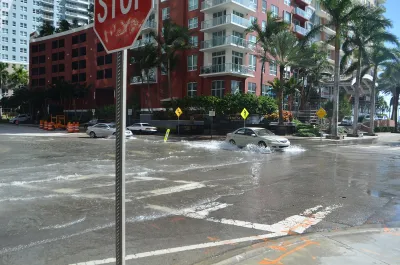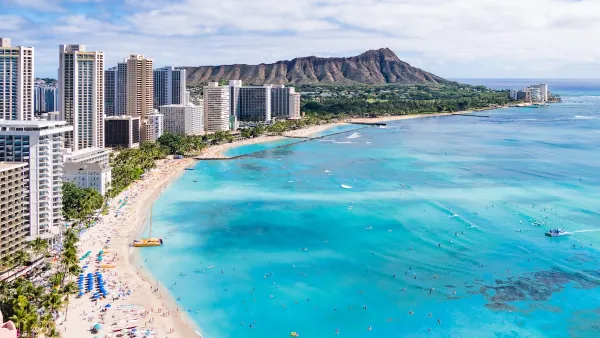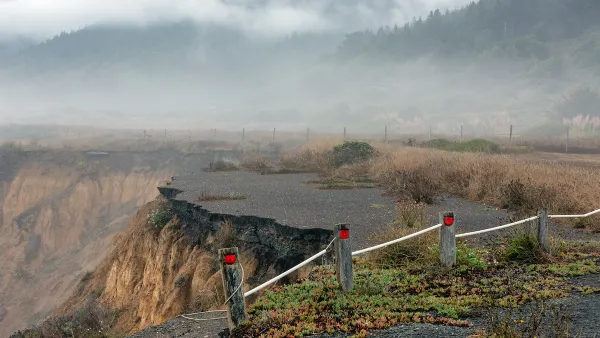As climate change accelerates sea level rise and flooding in South Florida, locals hope to mitigate the impacts with less dramatic interventions.

In the first draft of a federal study seeking ways to "protect the vulnerable South Florida coast from deadly and destructive storm surge," the U.S. Army Corps of Engineers proposes building a six-mile inland seawall–and not everyone is happy about the plan, reports Patricia Mazzei for the New York Times. "[T]he startling suggestion of a massive sea wall up to 20 feet high cutting across beautiful Biscayne Bay was enough to jolt some Miamians to attention: The hard choices that will be necessary to deal with the city’s many environmental challenges are here, and few people want to face them."
The problem in Miami, writes Mazzei, is not denial, but the sheer magnitude of the challenge. "None of the possible solutions are cheap, easy or pretty," and storm surge is just one of the concerns exacerbated by climate change. "Even when there is no storm, rising seas contribute to more significant tidal flooding, where streets fill with water even on sunny days. The expanding saltwater threatens to spoil the underground aquifer that supplies the region’s drinking water, and to crack old sewer pipes and aging septic tanks. It leaves less space for the earth to absorb liquid, so floodwaters linger longer, their runoff polluting the bay and killing fish."
Yet opposition to the seawall proposal "has produced a rare moment of agreement between environmentalists and real estate developers, who fear harm to the bay’s delicate ecology and lower property values." Miami-Dade County wants to prioritize the less controversial "[o]ther parts of the corps’s draft plan, which includes surge barriers at the mouth of the Miami River and several other waterways," "fortifying sewer plants and fire and police stations to withstand a crush of seawater," "[e]levating or flood-proofing thousands of businesses and homes," and planting mangroves to defend against erosion and flooding.
Locals tend to agree with taking more measured steps. "In fact, when local governments have asked the public how they would like to tackle climate change, residents by far prefer what is known as green infrastructure: layered coastal protection from a mix of dunes, sea grasses, coral reefs and mangroves, said Zelalem Adefris, vice president for policy and advocacy at Catalyst Miami, which works with low-income communities in the county."
Army Corps officials insist that, with the current pace of climate change and sea level rise, "they see no way around what they call structural elements." Niklas Hallberg, the study’s project manager, "said the corps is committed to working with the community in the next phase of design for the project, so 'maybe it doesn’t look like so much of a wall.'"
FULL STORY: A 20-Foot Sea Wall? Miami Faces the Hard Choices of Climate Change.

National Parks Layoffs Will Cause Communities to Lose Billions
Thousands of essential park workers were laid off this week, just before the busy spring break season.

Retro-silient?: America’s First “Eco-burb,” The Woodlands Turns 50
A master-planned community north of Houston offers lessons on green infrastructure and resilient design, but falls short of its founder’s lofty affordability and walkability goals.

Delivering for America Plan Will Downgrade Mail Service in at Least 49.5 Percent of Zip Codes
Republican and Democrat lawmakers criticize the plan for its disproportionate negative impact on rural communities.

Test News Post 1
This is a summary

Test News Headline 46
Test for the image on the front page.

Balancing Bombs and Butterflies: How the National Guard Protects a Rare Species
The National Guard at Fort Indiantown Gap uses GIS technology and land management strategies to balance military training with conservation efforts, ensuring the survival of the rare eastern regal fritillary butterfly.
Urban Design for Planners 1: Software Tools
This six-course series explores essential urban design concepts using open source software and equips planners with the tools they need to participate fully in the urban design process.
Planning for Universal Design
Learn the tools for implementing Universal Design in planning regulations.
EMC Planning Group, Inc.
Planetizen
Planetizen
Mpact (formerly Rail~Volution)
Great Falls Development Authority, Inc.
HUDs Office of Policy Development and Research
NYU Wagner Graduate School of Public Service





























